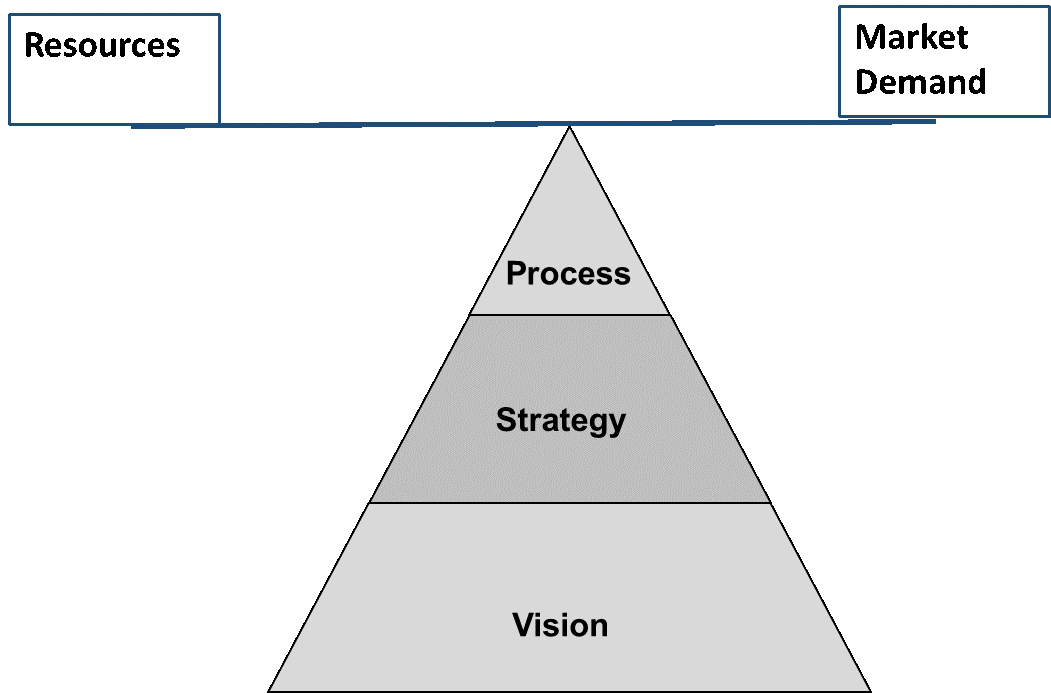Before an organization can embark on the journey to Organizational Excellence there are some conditions that need to exist beforehand. The five essentials are pre-existing conditions provide the foundation upon which the tools of Organizational Excellence are built.
The five essentials of Operational Excellence assumes that the organizational leadership and each functional area has a vision and a structure to direct its efforts, operates to principles, needs people to deliver value and tools to help develop basic capabilities and processes.
The five essentials of Operational Excellence are:
- Vision
- Structure
- People
- Principles
- Tools
Each is an essential and critical element, creating a whole that is greater than the sum of the parts.
1. Vision
Vision refers to understanding why the organization exists, why it was set up, what are its objectives – its strategy to create and deliver value to its customers and stakeholders. Typically, there is a balance between meeting the needs and demands of all these. The value system of an organization defines who the stakeholders are and how that balance will be achieved. That value system defines who we are collectively and how we operate. If it is not well defined, if we choose to accept mediocrity or bad practice in any area, then we will limit our combined capabilities in both the short- and long-term. Such basic choices are at the heart of an organization – and they are choices; they are a matter of leadership and management. The value system of an organization defined by the words and the actions of the leadership team, which refers to leaders at all levels in an organization, starting with senior management level, but not limited to only senior management.
2. Structure
Businesses are complex, typically made up of people, often from different professional backgrounds and experiences, working together to achieve something. The ‘something’ is usually a profit, through serving customers. But many of the issues that arise when trying to do business come from the fact that we tend to organize ourselves according to functional activities.
How we decide to organize ourselves has a major impact on our ability to ‘get things done’. The same resources can deliver drastically different results, depending on how they are organized. Are we working together as a cohesive whole or as separate entities that are competing internally? The application of BPM (Business Process Management) attempts to expose the cross functional nature of how work is actually performed in an organization.
Strategy – A Dynamic Balance
The model below outlines a balance that I describe as a dynamic balance between Market Demands and your Resources, which balances on the Internal Capabilities of your people, which change as they develop capability and experience under the direction of Leadership, Strategy and Vision.
Organizations are formed to ‘do something’, to achieve ‘something’. We describe the thinking behind the ‘something to be done’ as the Vision, Mission and Strategy for the organization. Some people seem to think that strategy is a given – a fixed thing – but in the real world of organizations, strategy is, and needs to be, a dynamic thing that evolves, responds and develops to changes in the environment. While strategy needs to be flexible, it also needs to balance a several often-conflicting demands. Generally, strategy is the balance between the vision and mission of the senior management team of the organization, and supported by the internal capabilities of people and processes. The balance point arises where the two meet and it is on this balancing point that the company tries to meet the needs and wants of its customers with the resources available to it. The balance is constantly changing as the capabilities of people and processes develop, market conditions change either in terms of customer demands or competitor offerings or in terms of the resources available and their capacity to get the job done. Given this unstable balancing act, the organization and development of our human resources becomes fundamental to the success or failure of our efforts.
People work in their own department, doing their best to achieve their goals and objectives. But the business frequently under-achieves. Structures have evolved to address this issue, recognizing the need for better communication and shared effort. The evolved way of representing this development can be represented as below, where high degrees of communication are developed and communication is facilitated between the different departments of the business.

3. People
We rely on our people to their job, to be the interface between our customers and our business, between our machines and our processes. We often hear the adage that our people are our biggest asset, but do we take this seriously? If our people are our biggest asset, who among our people are the biggest asset? And what are we doing to develop them, to nurture them and challenge them?
Within the People essential, there are again five key elements:
- Fairness
- Firmness
- Consistency
- Staff development
- Leadership development
Fairness means that we need to be fair to our staff and equally our staff need to be fair to the business. This concept of what fair can go a long way to finding a balance for all within an organization. Many problems arise when either management or staff diverge from the basics of a fair system.
Firmness is an essential element for an effective process. If we know what is required to deliver good service, to make a good product, then it is essential that knowledge is applied and used consistently to do just that. People need to follow the agreed procedure to ensure and assure that the process is delivered well.
Consistency refers to how we deal with our people, irrespective of our personal dispositions. All people need to be assured that they will get a fair return for their efforts, based on the work and not just their status or perceived status.
Staff Development refers to the need to be able to create a real, worthwhile developmental path for our people, to give them a clear opportunity to develop themselves, their capabilities, their experience and their expertise. By developing these aspects, they will be developing their ability to contribute more Value to the business.
The development of leaders with an organization. Generally, when we hear the word leaders is often to think of the senior management team in a business, but a broader view of leader includes people at all levels throughout an organization who choose to participate to make things better. These are the people who will look at what is being done and who will try to find ways to make a difference for the better.
4. Principles
Operational Excellence is an element of organizational leadership that stresses the application of a variety of principles, systems, and tools toward the sustainable improvement of key performance metrics.
This can be boiled down to seven areas that organizations must excel at:
- Strategy – leadership creates vision and values and refine it into strategic focus and direction
- Metrics – balanced scorecards cascaded down through the organization
- Culture – staff understand the strategy and accountable for the results
- Processes – integrated business process architecture (BPM)
- Methodology – applying discipline and rigor to continuous improvement through Lean Six Sigma (LSS)
- Project Management – applying discipline and rigor to projects (PMBOK)
- Tools – solution delivery (processes, products and services), problem solving and continuous process improvement
5. Tools
Tools let you move from concepts and ideas into action. There are many tools to choose from but in order to simplify there are fundamental tools:
- Project Management
- Teams
- Process Mapping
- Lean Six Sigma
Project management rigor provides guidelines to be successful with the various activities within the organization.
Process Mapping provides a way for people to see what is the actual tasks within their operations. Not what they think is happening, but what is being accomplished.
Teams are at the very heart of a successful organization. People need to engage, to decide to be a part of something bigger than themselves and the use of Teams provides such an opportunity, in a structured and coherent way.
The tools and concepts are essential to the delivery of true excellence in business. The tools and techniques presented carry a subtlety and a power that goes beyond the norm. They are intentionally simple. They are the basics that can be used throughout all businesses to help people improve their processes and their performance.
To be successful, you must work with what you have and build your ability to use it and whatever other resources you have available to you to meet your customers’ needs and requirements.

















